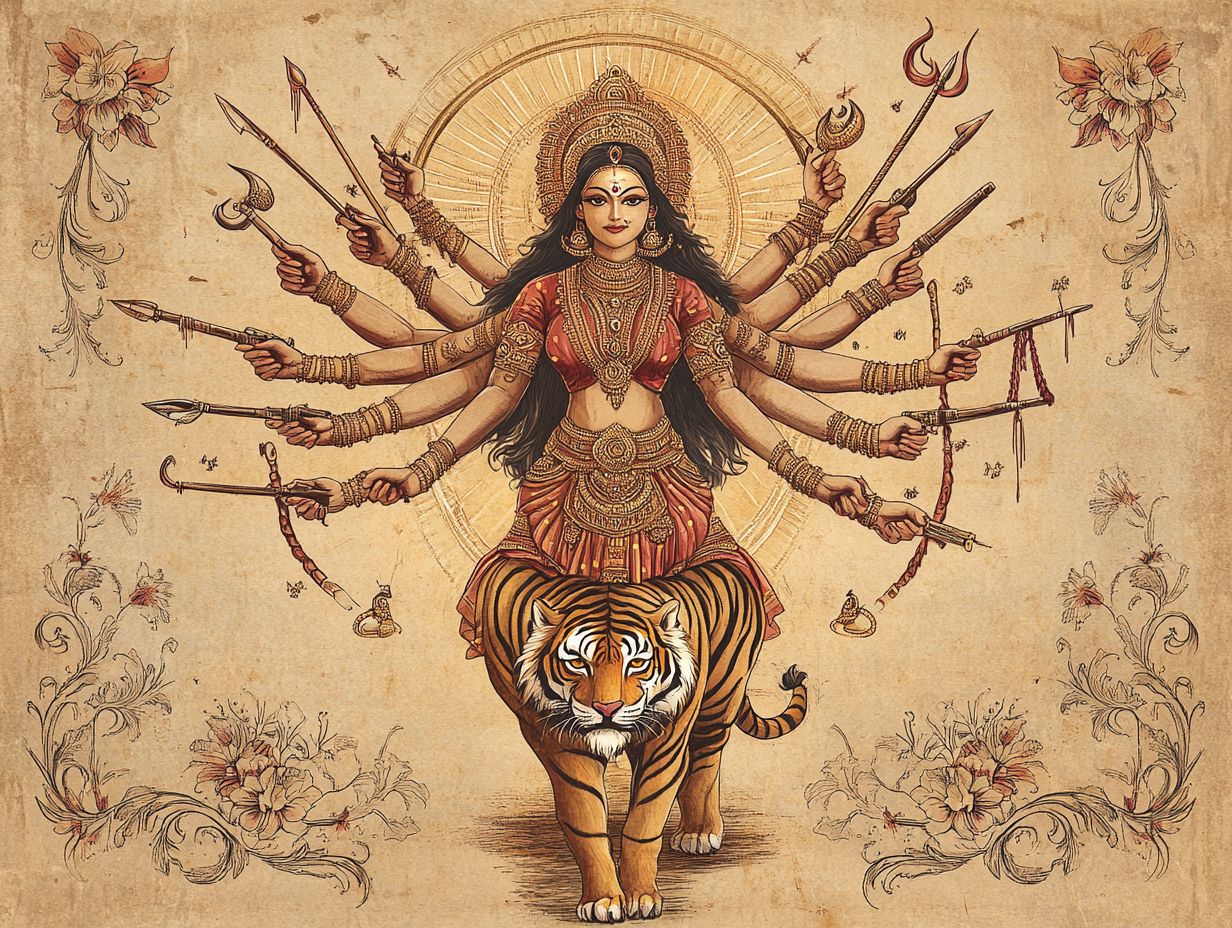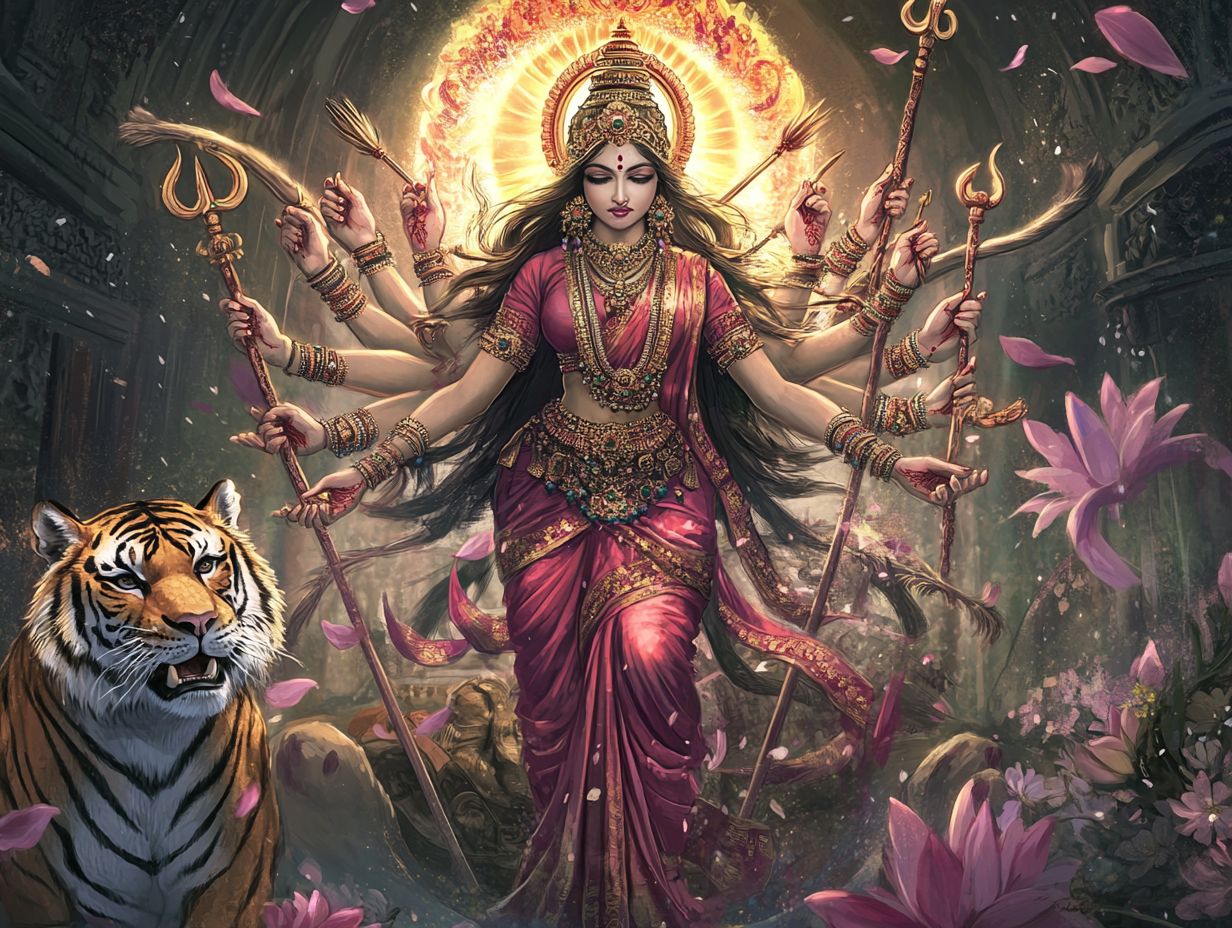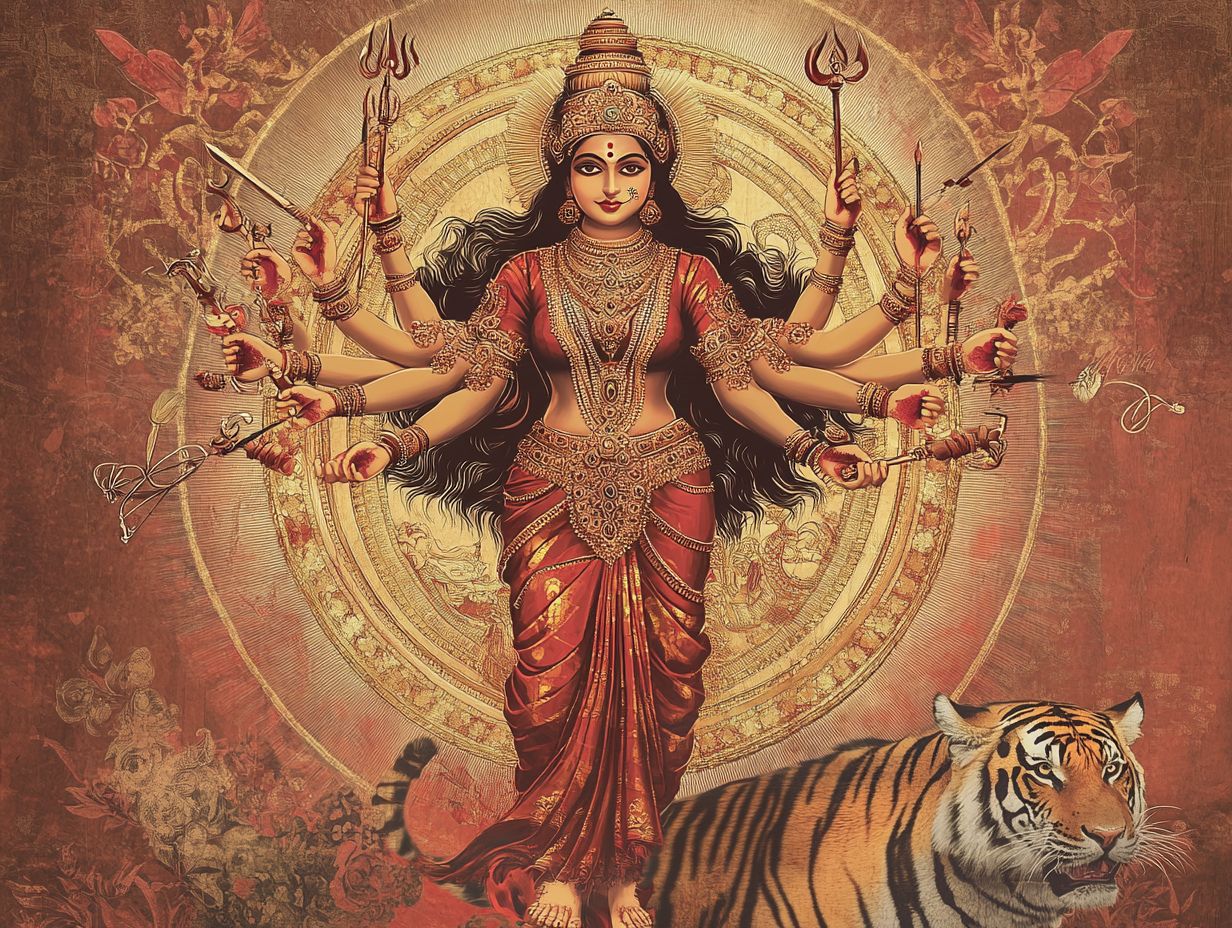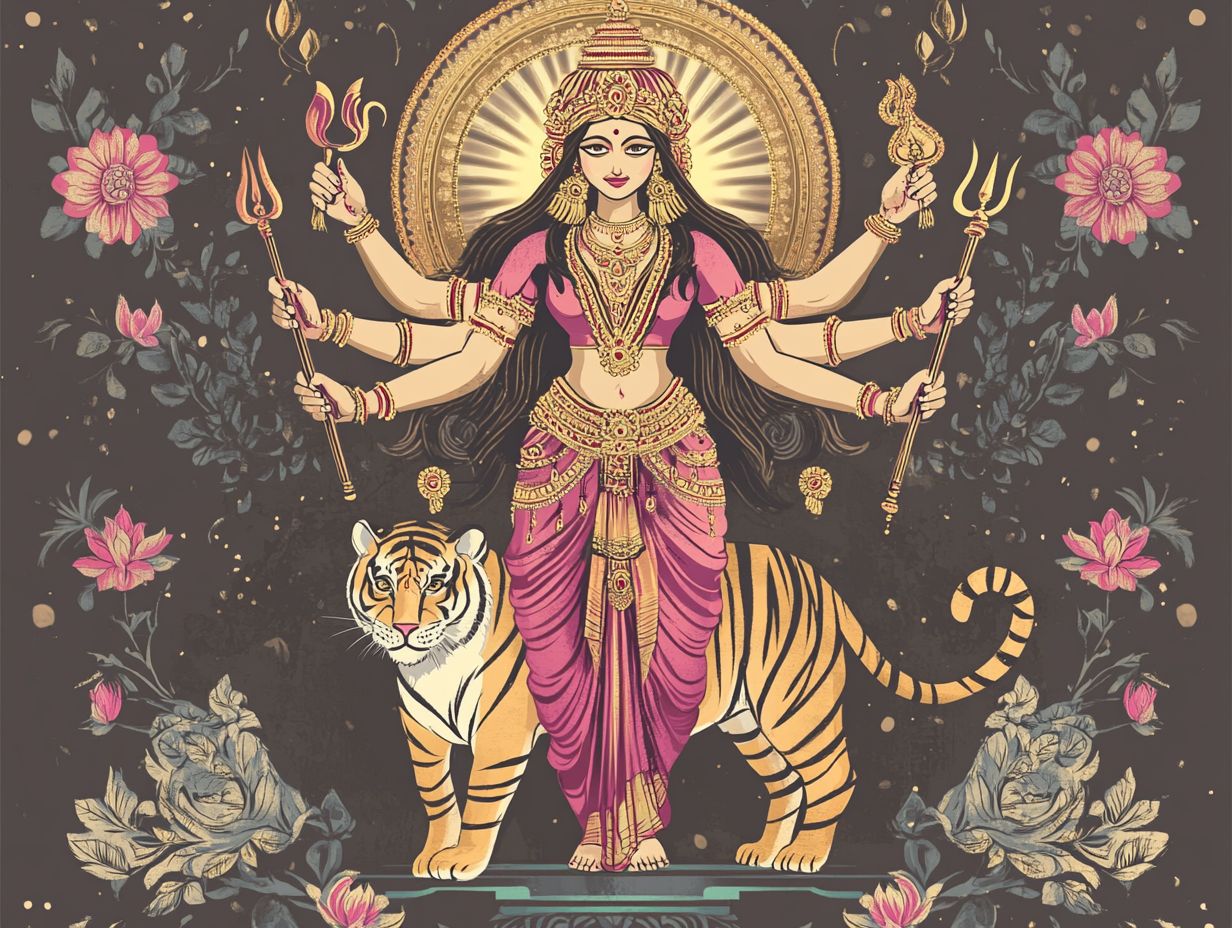What is Shakti in Hinduism?
Shakti, a central tenet in Hinduism, represents the divine feminine energy, or Devi, that fuels creation, transformation, and destruction. This energy manifests in a variety of forms, each symbolizing a distinct facet of this formidable force. From the primordial Adi Shakti to the transformative Kundalini, Shakti’s influence is woven throughout spiritual practices, rituals, and narratives, reflecting a deep tradition of Shaktism.
This exploration delves into the myriad forms of Shakti, examining its representations within Hinduism, its essential roles, and the vibrant celebrations, including Shakti Peethas, that pay homage to this powerful energy. One can uncover the essence of Shakti and its profound significance in shaping the spiritual landscape of Hinduism, particularly within the context of devotion and worship.
What Does Shakti Mean?

In the context of Hinduism, Shakti embodies the divine feminine energy and power, or divine presence, that manifests in various forms, symbolizing both creation and destruction within the cosmic dance of existence.
This sacred concept represents the nurturing and transformative forces that govern the universe, facilitating a balance between duality and unity while supporting individual spiritual journeys toward enlightenment.
The understanding of Shakti is intricately woven into the philosophy of Hindu cosmology, where it is deemed essential to the spiritual journey and enlightenment of the individual. This highlights the significance of the feminine principle and cosmic balance in the grand tapestry of life.
What Are the Different Forms of Shakti?
Shakti manifests in various forms, each embodying unique dimensions of the divine feminine energy that permeates existence and shapes spiritual and cosmological realms.
The diverse expressions of Shakti, such as Adi Shakti, Mahashakti, Yogamaya Shakti, Kundalini Shakti, and Prakriti Shakti, are revered in both worship and Tantric practices, showcasing their formidable attributes and transformative potential.
These forms provide profound insights into the complexity of divine forces, highlighting the multifaceted essence of goddess worship and the rich symbolism inherent in each aspect of Shakti, often explored through various spiritual practices and mystical experiences.
1. Adi Shakti
Adi Shakti embodies the primordial energy and divine mother within Hindu cosmology, encapsulating the very essence of cosmic creation from which all forms of energy and matter emerge.
This divine feminine force is venerated as the wellspring of all existence, intricately woven into the universe’s fabric. In Vedic texts, Adi Shakti often appears as a dynamic goddess, bestowing life and vitality to all beings, thereby nurturing the interconnectedness of creation and symbolizing the sacred feminine archetype.
This sacred energy manifests not only in the physical realm but also resonates through the corridors of cosmic consciousness, underscoring the unity inherent within diversity. The association of Adi Shakti with sacred geometry reveals the fundamental patterns that govern the cosmos, offering a visual testament to the divine mother s integral role in the perpetual cycle of creation, preservation, and dissolution, reflecting the cosmic feminine and its influence.
2. Mahashakti
Mahashakti represents the supreme energy that is omnipresent, embodying all facets of the divine feminine and empowering both creation and transformation within the universe.
This profound force encapsulates the essence of nurturing, wisdom, and strength, serving as a foundational element for spiritual practices across various cultures. Practitioners frequently strive to connect with this divine energy to facilitate personal growth and healing, leveraging its transformative power to transcend obstacles and realize their true potential, often through the use of mantras and meditation.
By engaging with Mahashakti, individuals may attain heightened awareness, enhanced intuition, and a deeper comprehension of the interconnectedness of all life. This sacred energy acts not only as a catalyst for individual enlightenment but also as a wellspring of inspiration, motivating communities to embrace collaboration and collective empowerment on their spiritual journeys.
3. Yogamaya Shakti
Yogamaya Shakti represents the profound concept of divine illusion, playing an critical role in the spiritual awakening of individuals. It guides seekers through the intricate veils of duality and illusion, leading them toward higher consciousness.
This shakti is often perceived as the dynamic energy that shapes perceptions and experiences, assisting seekers in navigating the complexities of their daily lives while fostering an understanding of the interconnectedness of all existence.
In recognizing the transformative essence of this divine energy, one can glean insights into the underlying unity that persists amidst apparent separateness, ultimately nurturing a deeper awareness of both the self and the universe.
Embracing Yogamaya Shakti amplifies one’s capacity to transcend conditioned responses, encourages personal growth, and illuminates the path toward a more conscious existence. In this enlightened state, duality is not viewed as a hindrance but rather as a catalyst for spiritual evolution.
4. Kundalini Shakti
Kundalini Shakti is often described as the serpent energy coiled at the base of the spine, symbolizing the immense potential for spiritual awakening and enlightenment through the unblocking of chakras. This potent energy serves as a cornerstone of numerous yoga and meditation practices, where practitioners diligently strive to awaken it through disciplined techniques and focused introspection. The flow of this spiritual energy is essential to achieving higher states of consciousness and inner strength.
As Kundalini Shakti ascends along the spine, it activates the chakras crucial energy centers within the body that correspond to various physical and emotional states. Each chakra plays a pivotal role in the transformational journey, influencing a range of experiences from stability and creativity to love and spiritual insight.
By leveraging the capabilities of Kundalini energy, individuals can undergo profound shifts in consciousness, ultimately fostering a deeper connection with themselves and the universe. This process not only promotes give the power toment but also enhances holistic well-being.
5. Prakriti Shakti

Prakriti Shakti embodies the divine feminine aspect of nature, encapsulating the cosmic forces that uphold balance and harmony throughout the universe while influencing the dualism inherent in existence. It reflects the dynamic interplay of the sacred feminine and cosmic energy within all living beings.
This dynamic energy permeates all living beings, serving as a reminder of their interconnectedness with one another and with the environment. As the nurturing force that inspires growth and renewal, Prakriti Shakti underscores the significance of recognizing the relationships among all elements within the natural world. It operates through cycles of creation, preservation, and dissolution, elegantly illustrating the delicate interplay between opposing forces and reflecting the philosophy of nature worship.
By embracing the feminine qualities of intuition, compassion, and creativity, individuals can attune themselves to the rhythms of nature, fostering a profound understanding of life’s complexities and the essential harmony that exists within the cosmos. Prakriti Shakti also enhances therapeutic practices and holistic well-being.
How Is Shakti Depicted in Hinduism?
In Hinduism, Shakti is frequently portrayed as a goddess, embodying the diverse manifestations of divine energy that encompass the nurturing, transformative, and protective qualities of the divine feminine. Shakti embodies both the sacred feminine and the cosmic forces that drive existence.
As the consort of Shiva, she represents the essential equilibrium between creation and destruction, positioning herself as a crucial figure within Hindu mythology and spiritual practices. This divine union reflects the duality and unity consciousness that pervades spiritual teachings.
Through her rich symbolism, Shakti elucidates the complex interplay between divine feminine and masculine energies, underscoring the significance of goddess worship in the cultural tapestry of Hinduism and its profound religious practices.
1. As a Goddess
Shakti, regarded as a goddess, embodies the essence of divine feminine archetypes, symbolizing strength, compassion, and nurturing. These qualities are celebrated through a rich tapestry of worship, rituals, and spiritual practices within Hinduism.
Each manifestation of Shakti Durga, Kali, Parvati, and Saraswati represents distinct attributes that resonate deeply with devotees. Durga, often depicted as a fierce warrior riding a lion, symbolizes an indomitable force against evil and negativity, showcasing unparalleled courage and resilience. These goddesses also highlight the cultural significance and empowerment of the feminine divine.
In contrast, Kali, enveloped in darkness with an aura of fierceness, emphasizes transformation and liberation from fear, serving as a profound reminder of the cyclical nature of life and death.
Parvati, the nurturing mother goddess, embodies love, fertility, and devotion, underscoring the significance of family and relationships in spiritual life. Meanwhile, Saraswati, the goddess of knowledge and the arts, inspires creativity and wisdom, encouraging a lifelong pursuit of learning and enlightenment. These archetypes are central to the feminist theology and empowerment of women within Hindu beliefs.
Together, these diverse forms of Shakti illuminate the multifaceted nature of feminine divinity, each playing an essential role in spiritual practices and cultural celebrations, weaving a rich narrative that celebrates the divine feminine and the sacred energies that shape existence.
2. As a Divine Energy
As a divine energy, Shakti permeates the universe, embodying the universal force that empowers individuals through their spiritual journeys and meditation practices. This sacred essence not only influences personal paths but also weaves connections among all beings, fostering a profound sense of unity and purpose, and supporting the flow of spiritual energy and inner harmony.
When individuals engage in meditation, they access the vibrant flow of Shakti, which enhances their spiritual awareness and enriches their lives. Such practices often unveil profound insights and catalyze self-discovery, transforming perceptions of both the world and oneself.
Embracing Shakti cultivates personal empowerment, guiding individuals to harness their innate potential and achieve a harmonious balance within themselves and in relation to the universe. This process reflects the influence of the divine feminine and the cosmic energy that binds all creation.
3. As a Consort of Shiva in Hinduism
Shakti, as the consort of Shiva, embodies the divine union of feminine and masculine energies, creating the essential balance within the cosmic forces that govern both creation and destruction. This partnership transcends mere symbolism; it illustrates the profound harmony that exists between opposites, underscoring the notion that neither force can thrive in isolation. This divine couple symbolizes the duality and unity consciousness inherent in cosmic balance.
The synthesis of Shakti’s nurturing essence and Shiva’s transformative power serves as a testament to their collaborative role in sustaining the universe. In acts of worship, this sacred union is celebrated through a variety of rituals and festivals, which underscore their integral contributions to maintaining cosmic order. The veneration of this divine couple inspires devotees to pursue balance in their own lives, fostering an understanding of the necessity of both energies in cultivating a harmonious existence.
What Is the Role of Shakti in Hinduism?
The role of Shakti in Hinduism holds immense significance, embodying the dual forces of creation and destruction. It nurtures and protects life while guiding individuals toward liberation and enlightenment through the empowerment of divine feminine energy. This divine power is integral to the practice of Shaktism, where Shakti is revered as the ultimate Goddess.
This multifaceted essence of Shakti illustrates its central place in the spiritual tapestry of Hindu belief, where it harmonizes the complexities of existence and fosters a deeper connection to the divine.
1. Creation and Destruction

Shakti embodies the duality of creation and destruction, representing a cosmic force that perpetuates the cycle of life and death within the universe. This profound energy manifests in various mythological narratives, wherein she often appears as goddesses who not only initiate the creation of new worlds and beings but also bring about necessary endings to restore balance. This dual nature is central to Indian mythology and the understanding of the cosmic creation process.
In Hindu mythology, for example, the goddess Kali is recognized as the fierce aspect of Shakti, symbolizing the destruction of the ego and ignorance. This destruction ultimately paves the way for rebirth and enlightenment. Similarly, the story of Durga s victory over the buffalo demon Mahishasura illustrates that Shakti’s transformative power transcends mere annihilation; it is fundamentally about the establishment of cosmic order.
These mythological accounts convey a deeper spiritual understanding that creation and destruction are interconnected processes, essential for evolution and harmony within the universe. They also highlight the role of Shakti in maintaining cosmic order and the sacred geometry of the cosmos.
2. Protection and Nurturing
Shakti embodies a crucial role in both protection and nurturing, often revered as the divine mother who safeguards and empowers her devotees through an abundant well of compassionate energy. Her presence is celebrated in various ritualistic practices and religious practices throughout Hinduism.
This nurturing essence encapsulates the very spirit of feminine power, serving as a profound source of strength and resilience. Portrayed as a loving figure, Shakti inspires individuals to acknowledge and embrace their inherent potential, all while fostering a deep sense of security and support.
Through empowered rituals that pay homage to her presence, devotees access a transformative energy that promotes self-discovery and personal growth. This divine mother figure instills unwavering confidence, enabling her followers to navigate the complexities of life with grace and a deep sense of faith.
Shakti s influence transcends mere protection; it cultivates a vibrant sense of community where communal rituals enhance the collective feminine energy, nurturing meaningful connections among individuals who seek empowerment together. The practices often draw from sacred texts and traditions that celebrate the feminine divine.
3. Liberation and Enlightenment
Shakti serves as a beacon of liberation and enlightenment, guiding individuals on their spiritual odyssey toward transcendence and self-realization through the empowerment of the divine feminine. This journey often involves practices such as tantra and meditation, which help in awakening the Kundalini and accessing higher states of consciousness.
In the realm of Hindu philosophy, Shakti represents the dynamic forces that invigorate and catalyze personal growth, enabling practitioners to awaken their inner strength and latent potential. Through a blend of rituals, meditation, and devotion, followers aspire to connect with this sacred energy, which not only nurtures the individual spirit but also cultivates a profound understanding of the interconnectedness of all existence.
By harmonizing the feminine energy within, individuals undergo transformative experiences that elevate their state of awareness and foster an expansive sense of unity with the cosmos. Ultimately, the journey with Shakti not only paves the way for personal liberation but also encourages a collective elevation in consciousness, promoting a world enriched with compassion and understanding. These practices reflect the philosophy and mysticism central to Hindu belief in the divine feminine.
How Is Shakti Celebrated in Hinduism?
Shakti is revered in Hinduism through a rich tapestry of festivals and rituals, such as Navratri, Durga Puja, and Kali Puja. These celebrations pay homage to the Goddess and her transformative power, profoundly influencing the lives of her devotees and highlighting the importance of the feminine principle in spiritual practices.
1. Navratri
Navratri is a vibrant festival dedicated to the worship of Shakti, where devotees immerse themselves in nine nights filled with rituals, dance, and deep devotion to her energy. The festival is a significant aspect of Shaktism and showcases the importance of the divine feminine.
During this sacred time, individuals partake in various practices that embody give the power toment and foster a profound connection to the divine feminine. Each night is dedicated to different forms of the goddess, inviting worshippers to reflect on the essential aspects of creation, preservation, and destruction.
Through fasting, traditional dances such as Garba and Dandiya Raas, and the heartfelt recitation of prayers and hymns, participants cultivate a strong sense of community and spiritual awakening. This festival not only honors the divine but also serves as a powerful reminder of the inner strength and resilience that resides within each individual, transforming it into a period of significant devotion and personal metamorphosis. Devotees often chant mantras of Shakti, invoking her divine presence and energy flow.
2. Durga Puja
Durga Puja is a magnificent festival dedicated to the goddess Durga, an embodiment of Shakti, celebrated through a tapestry of intricate rituals, cultural performances, and communal gatherings. This festival not only signifies the victory of good over evil but also serves as a crucial occasion for communities to unite, fostering connections through collective worship and joyous festivities. It highlights the cultural significance of Shakti in Hindu traditions.
In the days leading up to this grand celebration, artisans meticulously craft intricate idols of the goddess, symbolizing her formidable strength and graceful essence. Devotees immerse themselves in a variety of rituals, including the recitation of prayers, the chanting of sacred mantras, and the offering of flowers and sweets each act a testament to the deep reverence held for Durga.
The ambiance is further enriched by an array of cultural programs, featuring traditional dance and music, transforming neighborhoods into vibrant realms of devotion and celebration.
3. Kali Puja

Kali Puja stands as a profound festival dedicated to the goddess Kali, who epitomizes the fierce and transformative aspects of Shakti. This celebration is marked by rituals that invoke her strength and protective qualities. The festival serves as a reminder of the mystical experience and the cosmology related to Shakti’s energy manifestation.
Deeply embedded in the ethos of Shakti worship, the festival highlights the immense reverence for a goddess who embodies give the power toment and resilience. Devotees partake in intricate rituals, illuminating lamps and presenting flowers that symbolize the dispelling of darkness and ignorance. The chants and mantras recited during this auspicious occasion serve not only to honor Kali but also to summon inner strength and courage in facing life’s myriad challenges.
As attendees immerse themselves in these sacred practices, they frequently discover a renewed sense of purpose and vitality. Embracing the formidable spirit of the goddess, they are inspired to transcend obstacles and empower themselves in their everyday lives. These experiences are often complemented by the practice of Shaktipat, where the guru transmits spiritual energy to the devotee.
4. Shakti Peethas
Shakti Peethas are esteemed sacred sites within Hinduism, revered as the abodes of divine feminine energy. Their significance extends beyond mere locations; they are vital to Goddess worship and spiritual practices. These sites are key to understanding the spiritual energy and cosmic energy associated with Shakti.
These hallowed places are steeped in history, intricately linked to the legend of Sati, the beloved consort of Lord Shiva, and they symbolize the profound interplay between the material and spiritual realms. Each Shakti Peetha embodies unique aspects of the goddess, representing various forms of divine energy and give the power toment. Pilgrims and devotees journey to these sites to partake in rituals, seek blessings, and deepen their spiritual understanding, reflecting a deep reverence for feminine power ingrained in Hindu traditions.
By honoring these sacred spaces, individuals not only pay tribute to the divine feminine but also engage in a timeless legacy that weaves together generations through shared beliefs and practices.
Frequently Asked Questions
What is Shakti in Hinduism?
Shakti is a Sanskrit term that refers to the divine feminine energy and power in Hinduism. It is the primordial cosmic energy that is responsible for creation, preservation, and destruction. In the context of Hindu cosmology, Shakti embodies the feminine principle and is often seen as the Divine Mother or Devi, who manifests in various forms such as Durga, Kali, and Parvati.
What are the different forms of Shakti in Hinduism?
There are various forms of Shakti worshipped in Hinduism, including Goddess Durga, Goddess Kali, Goddess Lakshmi, and Goddess Saraswati. Each form represents a specific aspect of the divine feminine energy and cosmic balance. The Shakti Peethas are sacred sites dedicated to Shakti, emphasizing her presence and power.
Why is Shakti important in Hinduism?
In Hinduism, Shakti is considered the creative force of the universe and the source of all power. It is believed that the entire cosmos is powered by this divine energy, which also includes spiritual energy and consciousness. Worshipping Shakti can bring blessings, protection, and spiritual awakening, leading to inner strength and liberation.
How is Shakti worshipped in Hinduism?
Shakti is commonly worshipped in the form of a goddess through rituals, prayers, and offerings. Many temples in India are dedicated to different forms of Shakti, and devotees also perform special pujas, yagnas, and meditate on mantras of Shakti to honor her divine presence. Practices like Shaktipat and tantra are also used to connect with her energy flow and sacred vibrations.
Are there any festivals or celebrations dedicated to Shakti in Hinduism?
Yes, there are several festivals and celebrations that honor Shakti in Hinduism. Some of the popular ones include Navratri, Durga Puja, and Kali Puja, where devotees worship the goddess in all her fierce and benevolent forms. These festivals often involve ritualistic practices, dance, and art to celebrate the divine power and feminine divine.
What is the significance of Shakti in Hindu mythology?
In Hindu mythology, Shakti plays a crucial role in many stories and legends. She is depicted as a powerful and independent goddess who works alongside male deities to maintain balance in the universe and protect the world from evil forces. Shakti and Shiva exemplify the duality and unity consciousness within the cosmic balance, representing the sacred geometry and energy centers or chakras within the human body.
